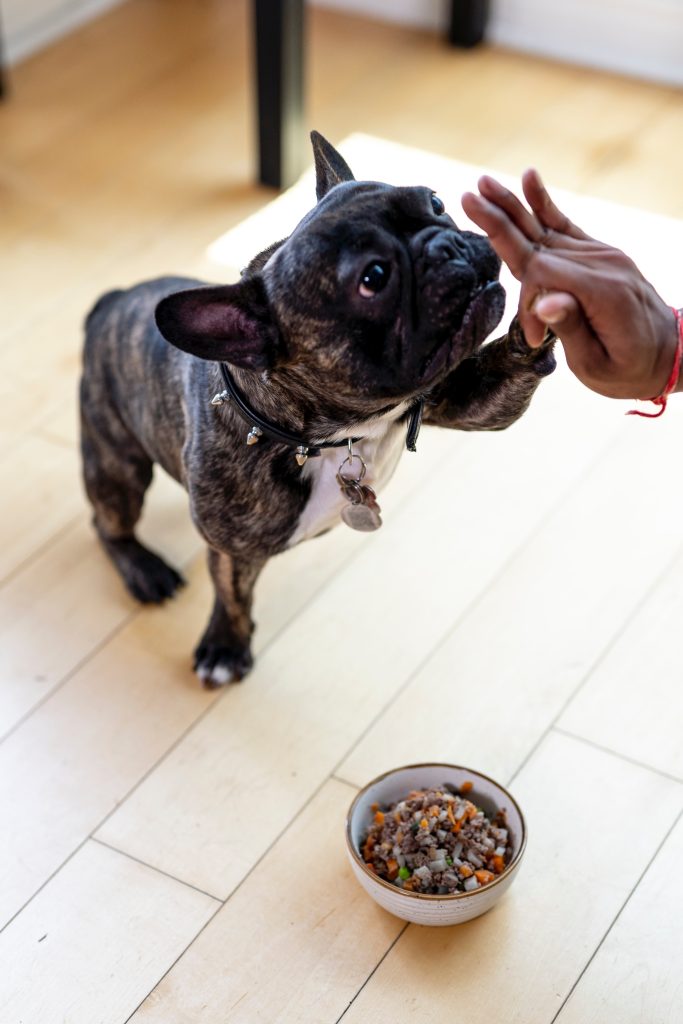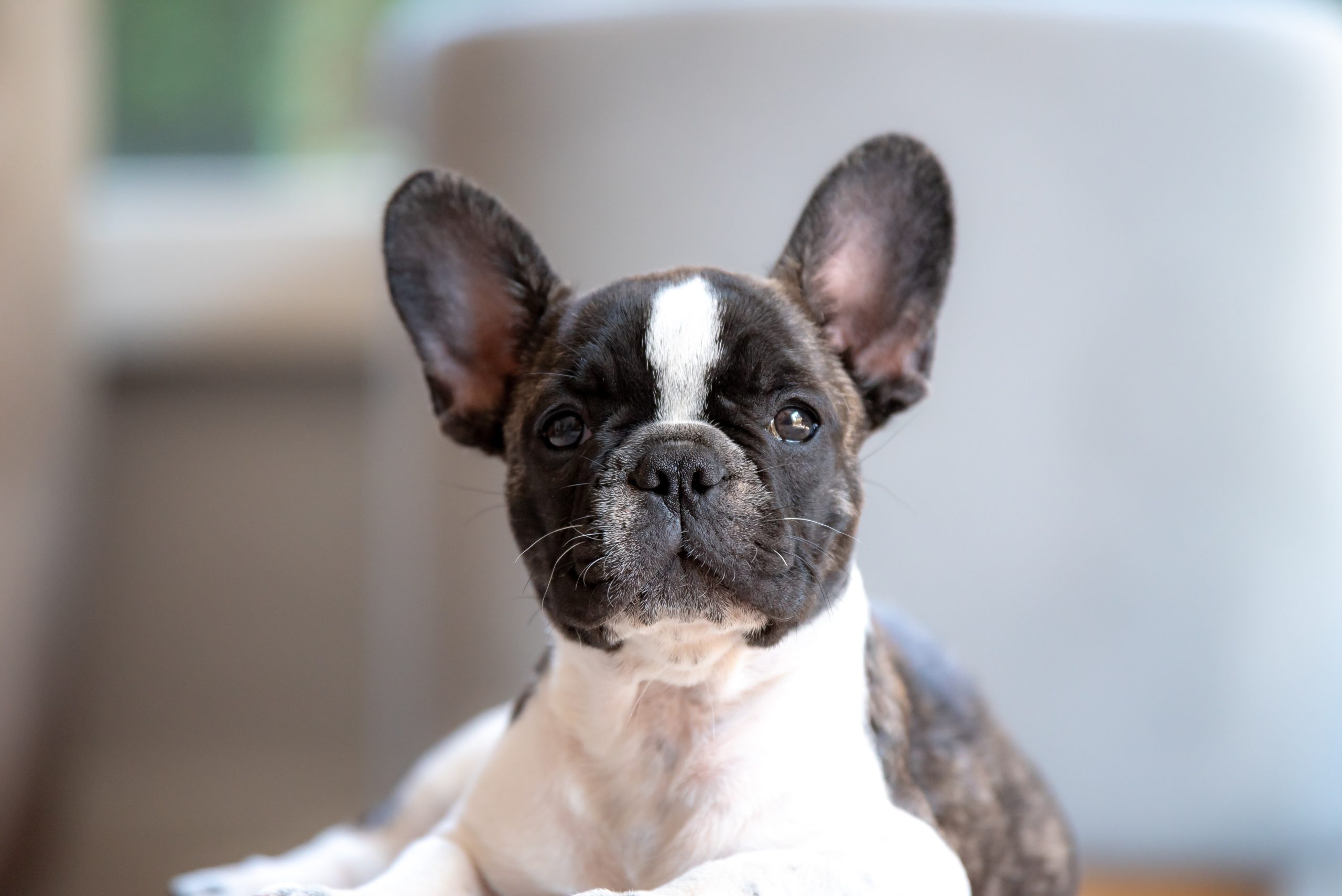Bat-eared but beautiful, the French Bulldog is a born lapdog. The French Bulldog isn’t just a pretty face – they are smart and, so long as their lessons are fun, are very trainable. They are very easygoing and love to be around people. Be aware that, like many brachycephalic breeds, the French Bulldog may have breathing problems, and is prone to overheating: keep your Frenchie cool on hot days to avoid heatstroke.
About the French Bulldog Breed Standard
French bulldogs are generally small to medium-sized, stocky, and compact with a heavy bone structure. The appearance of its relative breed, the English bulldog is slightly different. The head should consist of folds and wrinkles while being strong and broad, while the coat should be smooth and glossy. The dog should be sociable and lively while its disposition should be kind and courageous.
He may look formidable but not be aggressive or vicious at all. The eyes should be dark in color, moderate in size, and not sunken or bulging from the head. French bulldog ears should be set high on its head and should resemble those of a bat. The nose should be broad, black, and snubbed. The nostrils should be similar to the nose. French bulldogs possess massive jaws, which are square in shape. You should notice it’s underbite. This feature is very unique and key to bulldogs. Its teeth should be large and strong while the canine teeth wide from each other. The tails on a French bulldog should be short and straight.
The Frenchie appearance
There are a wide variety of colors that a bulldog may possess. The coat should be uniform and radiant. The colors include brindle, fawn, piebald or a combination of the previous colors.
You can easily recognize a French bulldog from its bat-like ears. Its coat should appear short, smooth, and glossy. Its skin should be soft and firm in nature.
The French Bulldog character
The French bulldog is an extremely social breed. They love to play with their owners and other dogs. If you plan to own a French bulldog, expect him or her to want to take over as the alpha without proper training. You need to establish that you are the leader while they are puppies in order for them to not become aggressive dogs.
Training your French Bulldog puppy

Training your Frenchie will be a fun and exciting experience for you and your dog. French bulldogs are very intelligent animals and tend to do a lot of their own thinking. Training should be started at a young age with lots of compliments and rewards for good behavior. Frenchie’s can be trained via obedience classes or on your own and can also be trained to compete in performance contests. Remember to have patience while you are training a puppy. It takes time and work but the experience and bonding that you and your puppy will experience will last a lifetime!
If you are looking for ideas on the perfect rewards for good behaviour, check out our article on the Best Treats to Train and Spoil your Puppy!
Living with the French Bulldog breed
French bulldogs can live in apartments or a house. They will be quite active at a very young age but as they get older that activeness will decrease. Something that is very important to remember with a bulldog is its ability to cool off. If you live in a house with a fenced-in yard, you must always remember that bulldogs overheat easily. They should not be left outside for long periods of time by themselves.
As with any dog, bulldogs should be taken on daily walks. These walks help with the anxiety of the animal while allowing it to get the necessary exercise it needs. Always remember that bulldogs thrive best in moderate climates but with the right care they can live in any climate.
Due to their affectionate nature, Frenchies can be a bit clingy. They often suffer from separation anxiety and will bark and chew up the place if left alone for too long. The Frenchie can also be a little slow to house train.
French Bulldog Health
What are brachycephalic breeds?
Brachycephalic, meaning “short-headed”, breeds have a distinct look with their flatter faces. Frenchies have shorter snouts, and the price of the adorably silly look they have is the risk of brachycephalic airway syndrome.
French Bulldog breed health issues
There are few health problems that may arise with French bulldogs due to their numerous folds and short, flat face. Before you decide to buy a bulldog, you should consider the followning risk factors that may arise with your New Doggy and remember that this specific breed may require more health monitoring:
Spinal disorders
Respiratory distress
Eye disorders
Hip dysplasia
The French Bulldog: Breed History

The French Bulldog owes a lot to the English Bulldog. While the latter was bred for the bloody and dangerous sport of bullbaiting, the former was intended to be a companion dog. The big, strong, and athletic bulldogs of the past were bred with pugs and terriers to reduce their size. This created a smaller dog with a rounded head and a short lower jaw. Many craftsmen kept these little dogs, especially lace-makers in Nottingham, England. So far, France wasn’t very involved in the history of the French bulldog, but this changed with the Industrial Revolution.
The Frenchification
The many machines and factories developed during the Industrial Revolution spelled disaster for many smaller craftsmen. Lace-makers suffered greatly, as machines had been invented that could do their work for less time and money. In the 1860s, many of the Nottingham lace-makers abandoned England for Normandy in the North of France, and many of the craftsmen took their little Bulldogs with them. The little bulldogs, nicknamed Bouledogues Français, became very popular in France, and breeders in England began to export their smaller or “imperfect” bulldogs to France. The little French bulldogs were popular pets for butchers, café owners, and even the Parisian “belles de nuit” (streewalkers).
High Society Lap Dogs
The little dogs eventually attracted the attention of the upper classes, and began to develop the dog we know and love today, with its compact body and straight, though lacking the undershot jaw of the English bulldog. The breed also spread to America when tourists fell in love with the little dogs, though they tended to prefer dogs with upright “bat” ears, while in France, both upright ears and “rose” ears (where the tip of the ear is folded) were accepted. An official American breeding program was created in 1885, and the American-bred dogs were displayed at the Westminster Kennel Club Dog Show in 1896.
The French Bulldog breed: In Decline
French Bulldogs became very popular on the East Coast of the USA. The popularity of the breed lessened after World War I. This was partly due to the popularity of the Boston Terrier, and partly because many French Bulldogs had difficulty giving birth safely. Veterinary medicine was not advanced enough for safe Caesarians to be performed at the time.
The Great Depression also lessened interest in purebred dogs.
World War II was a hard time for the French Bulldog. As lack of food led to the starvation of many dogs, as there was barely enough food in Europe for humans to eat, let alone for animals.
Is the French Bulldog the right breed for you?
Today, the Frenchie is one of the most popular dog breeds in the world. Many people are charmed by their bat ears, but just as much by their playful nature and easy-going personality. The French Bulldog isn’t just a pretty face. They are also clever dogs and, as long as their lessons are fun, should be easy to train. You may need to try a few different training techniques to see what works best for your Frenchie.
Like the English Bulldog, they can be a little stubborn, as they tend to think for themselves, are protective of their families, and make surprisingly good watchdogs. French Bulldogs love to be around people. They are good indoor dogs as they don’t need much room, and will be happy to live in an apartment and get on well with children. They don’t need much exercise, though a daily walk is needed to stop them from getting overweight.
If you want a playful yet relaxed family dog that is happy to live in a small house or apartment, the Frenchie may be the perfect pet for you.
Finding your dream Frenchie puppy
At adoptorbuy.com we do not support or endorse the buying of puppies from puppy mills. You have to be diligent in choosing the right breeder, one that can demonstrate the lineage history and adheres to the highest breeding standards.
It is hard work, and there might be no breeders in your area, which is why you might want to go with a reputable service provider that audits the breeders and administers the necessary health checks and vaccinations.
We recommend our sister company, NewDoggy, but you should still consider all options and make the choice best suited to you. Reviews from previous customers are always a good indicator!

